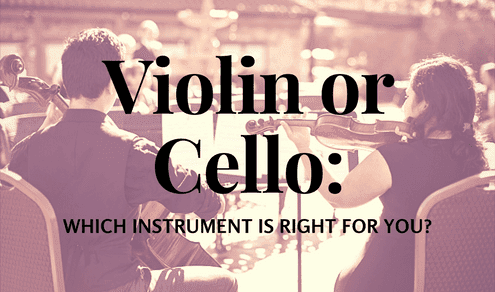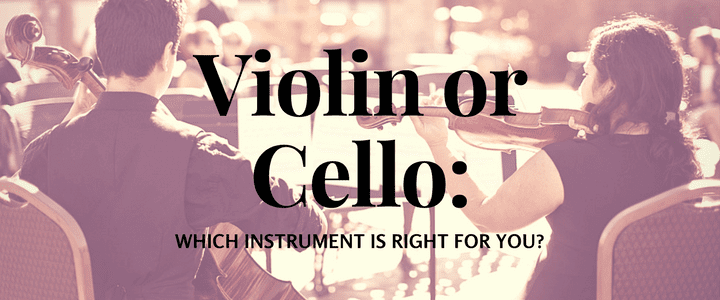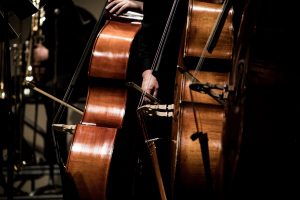Choosing whether to play the violin or cello can be difficult, but this article will help you consider the advantages and disadvantages of each.
The violin and cello are two of the most well-known and commonly studied instruments in the string family. Each one is central to the makeup of the orchestra we know today. Becoming familiar with the pros and cons of these two instruments will help you decide whether the violin or cello is a better fit for you.
Is it Easier to Play Violin or Cello?
When you’re trying to decide whether you should play the cello instrument or violin, you might be wondering, is the violin or cello easier? The answer isn’t always clear-cut. What is the difference between cello and violin? Here are a few key points to consider:
- Cellists have three clefs to learn instead of just one, so they can reach more notes
- The violin has a sound and range that is more similar to the sound of a human voice, which can be more relatable for some people
- Violins are cheaper to buy than cellos (good for a beginner on a budget or when you’re trying to decide between cello or violin for child learners)
- Positioning the violin can be challenging, both under the chin and in regards to the finger positioning
- The violin is more practical to transport due to its size
- It used to be harder to find cello lessons than violin lessons but that’s no longer the case – now you can find online lessons for both the violin and cello with ease so you can learn anywhere!
With those various pros and cons in mind, it’s best to make the decision for yourself. No two instruments will be as difficult for every single person to learn as others. Learning how to play music on the violin is easy for some, while learning cello will be much easier for others.
If you can, head over to your local music shop and give both instruments a try!
Violin or Cello – How to Decide
Which is better – violin or cello? There’s no real answer to that question as each instrument has its own camp. Here are some pros and cons of each to help make the decision of cello or violin easier on you.
Pros and Cons of the Violin
Is violin a good instrument to learn?
The violin’s most commonly cited advantage is that it’s practical. The violin is (on average) significantly less expensive than the cello. It’s also smaller and more portable. In addition, many people appreciate the violin’s range and tone, which is similar to that of the human voice.
Because the instrument has been popular now for around 400 years, there isn’t a shortage of repertoire to keep both budding and experienced violinists challenged. Within orchestras, spaces for violinists also tend to be the most numerous, so in that sense violinists have an advantage (especially over winds, brass, and percussion).
Compared to other string sections, however, the violin can also be more competitive because so many people play it. It might not be too difficult to earn a spot in the second violin section, but earning a place among the upper ranks can be more difficult.
Violins have very specific ways that they need to be held, too. You’ll hold the violin on your left shoulder (if you’re right-handed) with the strings facing the ceiling and the bow in the right hand. It’s the opposite for left-handed people. This position doesn’t leave much room for negotiation – but with the cello, you can try multiple different positions, sitting or standing to make it more comfortable for you.
Pros and Cons of the Cello
The cello is often cited for its practical disadvantages – mainly its size and expense. But for students who enjoy the sound of the cello more, hauling around a larger and more expensive instrument is well worth the care and effort.
The cello’s low register and tonality resonates with many musicians far more than the violin’s higher register.
Both the violin and cello have a unique range and repertoire that tend to draw different people. While violin repertoire is probably more extensive, the cello also has a well-established and diverse repertoire, including significant solo works.
Fewer students study the cello than the violin, so cellists are usually in higher demand than violinists. This tends to hold true even when taking into account the typically lower number of cellists required to create an orchestra or chamber ensemble.
Which is Harder to Play: Violin or Cello?
Many students wonder, which instrument is more difficult: the violin or cello? People who have tried both cello and violin tend to say the cello is less difficult due to its more natural position. The position of the violin can feel awkward at first, however advanced violinists insist that it becomes natural over time.
It’s something that’s important to master, though, as violin bowing technique can affect not only how comfortable you are while playing but also your tone. Here’s a video that demonstrates that principle quite well:
Many experienced musicians say that both instruments have their own difficulties. For example, although a cellist’s playing position is easier to learn, the thumb position on the cello is difficult for many students. Advanced cellists also must learn three clefs instead of just one.
SEE ALSO: How Easy is it to Switch Instruments? [Infographic]
Is Cello or Violin Better?
Should I learn cello or violin? It’s a tough call.
Music students and their families can do a number of things to help them in their decision.
- First, consider what opportunities are available at school or in the community. Keep long term goals in mind.
- Make sure the student has exposure to both instruments. Learning what is a cello instrument and what is a violin would be helpful. This can include videos, CDs, or local concerts. Local colleges and conservatories often perform concerts for the general public and many of these feature the violin and cello. Local symphonies also put on free concerts in the park.
- To be sure you’re making the right choice, it’s always a good idea to sample each instrument and take a couple lessons. Check out this directory of violin teachers, and this directory of cello teachers. Lessons are available both in-person and online all over the country.
- Listen to some basic orchestral music and try to pick out the different sounds of both the violin and the cello. This will give you a feel for what each instrument adds to ac composition and to decide which one you prefer.
- Go to a music shop so you can feel both instruments – consider the size, weight, and how your body feels holding the instrument.
- Above all, the student should love the sound of whichever instrument they choose, whether it’s the higher and more cheerful violin or the deeper and rich cello.
What are your thoughts on whether the violin or cello is a better instrument? Let us know in the comments below!
Carol Beth L. teaches viola and violin in Sacramento, CA. She currently plays viola in the Rancho Cordova Civic Light Orchestra and has been teaching students since 2012. Learn more about Carol Beth here!
Jessica Dais





